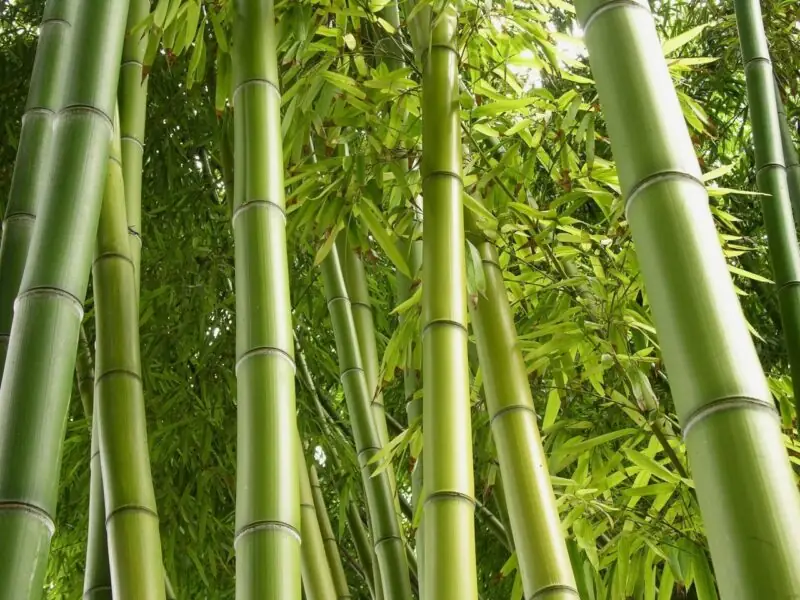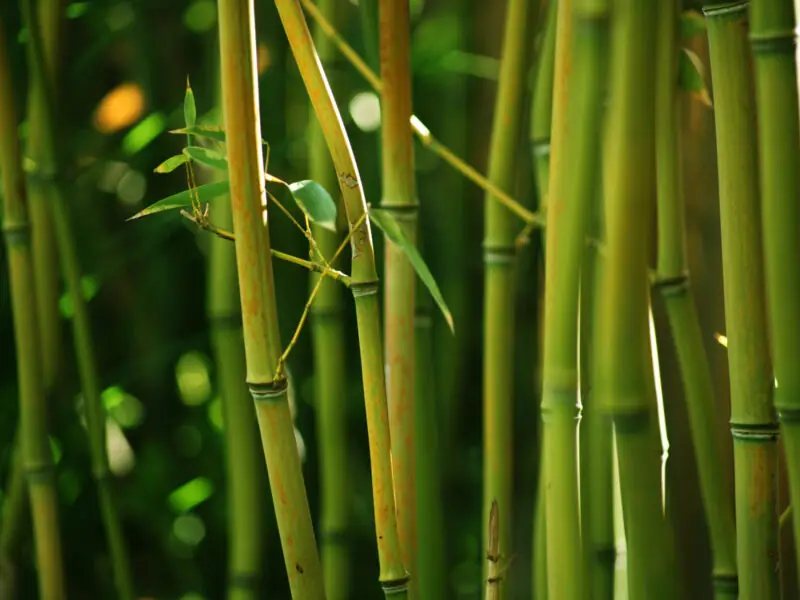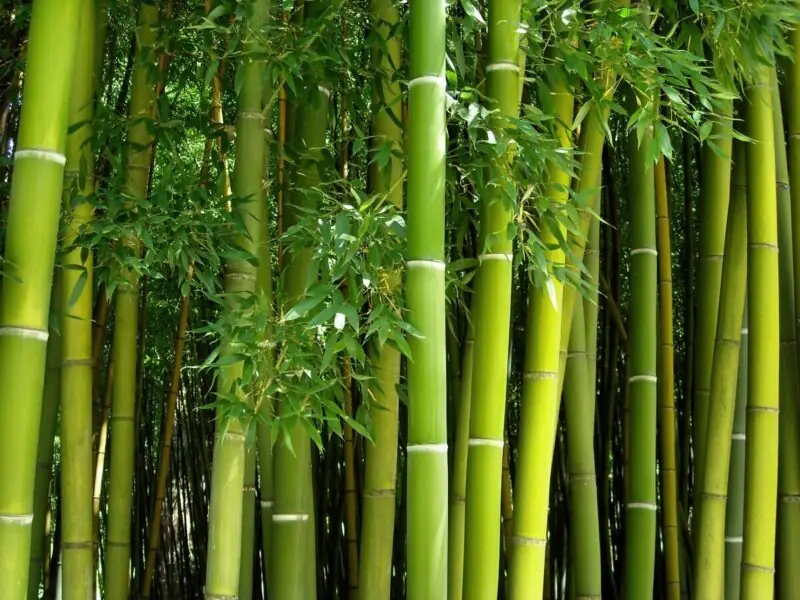How to Grow Bamboo Plant: A Comprehensive Guide

Hey there, bamboo enthusiasts! Are you ready to embark on an exciting journey through the world of this incredibly versatile and robust plant? You’ve landed at the right spot! This article aims to be your ultimate guide, revealing all there is to know about bamboo: its unique properties, classifications, propagation, and the vast array of applications it boasts.
What is Bamboo
Understanding the Bamboo Plant
Let’s kick things off by getting to know the basics. Bamboo, with more than a thousand species across the globe, is part of the grass family Poaceae, which also houses other familiar members like corn and wheat. These fascinating plants, ranging from miniature species to towering giants, are anything but ordinary.
Growing with an astonishing speed, some bamboo species can shoot up by 6 inches daily, making them some of the fastest-growing plants worldwide. That’s right, in the time it takes to bake a loaf of bread, a bamboo shoot could grow taller than your average 7 to 10-year-old kid! The mature culms, the term used for bamboo stems, are no less impressive. They can reach a diameter of several inches and tower up to 130 feet high, depending on the species. Now, that’s a skyscraper in the plant world!
The Unique Properties of Bamboo
Bamboo is not only fast but strong and flexible. Some bamboo species are so resilient, they surpass the strength of timber, demonstrating the astonishing might of this grass. This attribute makes bamboo an eco-friendly alternative to traditional wood, reducing deforestation and having a lower environmental impact.
The secret to bamboo’s rapid and robust growth lies in its rhizome system, a network of underground stems. Rhizomes allow the bamboo plant to grow and spread quickly, giving it the potential to transform a barren landscape into a lush, green vista in just a few seasons. This also means you can easily propagate new bamboo plants from an existing clump.
Classifications
Overview of Running Bamboo
The classification of bamboo is a vast subject, but let’s start with the running bamboo. Species like Arundinaria fall under this category, known for their vigorous growth and far-reaching rhizomes. These traits mean that running bamboo species can transform a small patch into a sprawling bamboo forest in no time.
The rhizomes of running bamboo grow horizontally, shooting out new culms as they spread. This can lead to a spectacular spread of new growth each year, especially if soil conditions are optimal. However, gardeners must be cautious, as running bamboo’s enthusiasm to grow quickly can lead it to become invasive in some regions.
Examination of Clumping Bamboo
Clumping bamboo is the tamer cousin of the running bamboo, staying put where you plant it. This bamboo’s growth pattern is to expand slowly from the original clump, growing new culms from the base. Clumping bamboo’s rhizomes grow in a U-shape, causing the plant to spread slowly and compactly. It’s the perfect choice if you prefer bamboo outdoors that won’t spread rampantly.
These species, including the genus Bambusoideae, are more manageable in a garden setting. Their predictable growth pattern allows for easier integration into landscape designs. They still share the same hardiness and adaptability of the running varieties, but they won’t take over your garden.
Where Does Bamboo Originate?
Bamboo’s Asian Roots
The origins of bamboo are strongly rooted in Asia. From the lush forests of Southeast Asia to the high altitudes of the Himalayas, bamboo is a significant part of the region’s ecology and culture. It has served as a source of food, construction material in Asia, and even as a material for writing. It’s a plant deeply intertwined with the lives of many Asian communities.
The Global Distribution and Adaptation of Bamboo
While its roots may be in Asia, bamboo’s distribution is now global. Thanks to its hardiness and adaptability, bamboo can grow in various climates, from the temperate zones of North America to the tropical regions of Madagascar. There are even bamboo species that can tolerate harsh winters!
Propagation
The Role of Clump and New Growth in Bamboo Propagation
Growing bamboo can be a thrilling experience, especially watching the new shoots begin to emerge in the early summer. The process starts when the bamboo produces new culms from the root mass, or clump. Each new cane will grow outward from the clump and expand the root system over time. With proper care, these new canes can reach full height and diameter within a single growing season of 3-5 years.
The Science Behind Bamboo’s Rapid Growth
Bamboo’s rapid growth is due to its unique rhizome system. Rhizomes allow bamboo to store nutrients, which are used to fuel the impressive growth of new shoots in the spring. Additionally, bamboo leaves act as a natural fertilizer. As they fall and decompose, they release nutrients back into the topsoil, fostering the bamboo’s growth.
How to Prepare the Planting Area
Site Selection for Optimal Bamboo Growth
Bamboo is quite versatile and can adapt to various locations. However, for optimal growth, choose a site with plenty of direct sunlight. Bamboo also appreciates a bit of wind protection. Consider factors like the mature height and diameter of the bamboo species you’re planting. A giant timber bamboo, for example, will need more space than a dwarf variety.
Soil Preparation for Bamboo Planting
Bamboo isn’t too picky about soil, but it does have its preferences. It likes well-draining soil, as waterlogged conditions can cause the roots to rot. If you have heavy clay soil, amend it with organic matter to improve drainage. Bamboo also prefers a slightly acidic pH. Before planting, till the soil and mix in some compost or well-rotted manure to give your bamboo a nutritional head-start.
How to Propagate Bamboo
Steps to Encourage New Bamboo Growth
Propagating bamboo is a simple process. You can propagate new plants by dividing the existing clump or harvesting the new shoots that emerge in spring. Ensure you take a section of the rhizome along with the cane or shoot. Plant the rhizome just below the surface of the soil, ensuring the cane or shoot is upright.
Techniques for Successful Bamboo Propagation
For successful bamboo propagation, timing is key. The best time to divide bamboo is just before the growth phase in spring, as the plant’s energy reserves are high. Once planted, water the new bamboo well, and continue to provide care as you would an established bamboo plant.
Planting Bamboo

Starting the Bamboo Plant
Once you’ve selected your site and prepared your soil, it’s time to plant. Dig a hole wide and deep enough to accommodate the bamboo’s rhizome and allow for future growth. Place the bamboo in the hole, backfill with soil, and tamp down lightly to remove air pockets. Water thoroughly after planting.
Strategies for Encouraging Healthy Bamboo Growth
After planting, spread a layer of mulch around the base of your bamboo to conserve moisture and suppress weeds. Bamboo enjoys moist, but not waterlogged, conditions, so water regularly, especially in dry periods. In the growing season, a balanced slow-release fertilizer can provide extra nutrients for optimal growth.
When to Plant Bamboo
Seasonal Insights for Bamboo Planting
Bamboo is truly an all-season plant, but if you’re planting bamboo, timing is everything. Spring is generally the best time to plant, giving bamboo a chance to root well before winter. In this season, new shoots begin to emerge and can reach their full height in a matter of weeks! Yes, you heard right, bamboo grows that fast! But avoid planting in peak summer when heat can stress your young plants. However, if you live in a mild climate, early autumn also works, just before the new growth phase begins. Whatever the season, always remember to water the bamboo thoroughly after planting. It will help your bamboo to settle down in its new home and start growing vigorously.
Tips for Timing Bamboo Planting
Spring is generally the best time to plant bamboo, as this allows the plant to establish itself before the next growth phase. However, if you live in a region with mild winters, fall can also be a good time. Bamboo is among the hardiest of plants, with some species able to withstand freezing temperatures. But, for best results, give your bamboo a chance to establish before the cold sets in.
How to Plant Bamboo
In-depth Guide to Planting Bamboo
Planting bamboo isn’t too complicated. First, dig a hole twice as wide and a bit deeper than the root ball. Position the bamboo so that the top of the root ball is level with the ground. Then, backfill the hole with soil and a bit of compost or slow-release fertilizer. Firm down the soil around the plant and water thoroughly.
Strategies for Ensuring Successful Bamboo Growth
To ensure successful bamboo growth, remember to mulch after planting. Bamboo benefits from a consistent watering routine, especially in the first few years. During the growing season, bamboo can also benefit from a balanced slow-release fertilizer to promote healthy growth.
Spacing
Understanding Spacing Requirements for Bamboo
Bamboo, like all plants, needs space to grow. The spacing you choose will depend on the specific bamboo variety you’re growing and its purpose in your garden. Some bamboo varieties can reach heights of 20 feet or more and can become quite large in diameter, making proper spacing essential.
How to Maximize Bamboo Growth through Correct Spacing
If you’re planting a bamboo screen or hedge, space plants 3 to 5 feet apart. For individual specimens, consider the mature size of your bamboo and allow enough room for full growth. Remember, bamboo loves to spread, so leave room for your bamboo to flourish.
Planting Depth
Importance of Planting Depth for Bamboo
Planting depth is critical for bamboo. The top of the bamboo’s root ball should be just below the surface of the soil. This gives the new shoots the best chance of breaking through the soil in the spring. Planting too deep can smother new shoots, while planting too shallow can leave the roots exposed.
Achieving Optimal Planting Depth for Bamboo
When you’re ready to plant, dig a hole deep enough so the top of the root ball is level with or slightly below the surface. Place the bamboo in the hole, ensuring it’s straight. Backfill with soil, firming it down gently around the roots. Then water thoroughly.
Crown Planting Recap

Key Points in Planting Bamboo
Remember the key points in planting bamboo: choose a suitable site with well-drained soil and plenty of sunlight, dig a hole twice as wide and a bit deeper than the root ball, position the bamboo so the top of the root ball is level with the ground, and water well after planting.
Review of Best Practices for Bamboo Planting
Some best practices for bamboo planting include preparing your soil with organic matter to improve its structure and nutrient content, maintaining a regular watering schedule, and feeding your bamboo with a slow-release fertilizer during the growing season.
How to Grow Bamboo
Light Requirements for Thriving Bamboo
While some bamboo varieties can tolerate a bit of shade, most thrive in full to partial sunlight. Too little light can result in lanky plants with few canes. Conversely, too much intense light can scorch the leaves. As a general rule, bamboo likes bright but indirect light.
Soil Preferences for Bamboo Growth
Bamboo isn’t overly fussy about its soil, but it does prefer a well-draining mix. If your soil is heavy clay or prone to waterlogging, consider amending it with organic matter or planting your bamboo in a raised bed. These beds, filled with a mix of topsoil, compost, and other organic matter, provide excellent drainage and ensure the bamboo’s roots don’t become waterlogged. Bamboo also appreciates soil that is slightly acidic to neutral in pH. While bamboo can tolerate less than ideal soil conditions, a good, nutrient-rich soil will promote fast-growing, healthy plants. So, go ahead and give your bamboo the best start by preparing the soil properly.
Water Necessities for Bamboo
Bamboo enjoys a good drink, especially during the dry season. Regular watering helps the bamboo to grow fast and stay healthy. The rule of thumb is to keep the soil moist, but not waterlogged. Too much water can cause the roots to rot, while too little can lead to yellowing leaves.
Mulching Techniques for Bamboo Care
Bamboo benefits from a good layer of mulch. This not only conserves moisture but also keeps the roots cool in summer and warm in winter. Organic mulch such as compost or straw gradually breaks down, adding nutrients to the soil and encouraging healthy bamboo growth.
Optimal Soil Conditions for Bamboo
For optimal bamboo growth, ensure the soil is rich, well-drained, and slightly acidic. Heavy clay or sandy soils can be improved with the addition of organic matter. To prevent waterlogging, make sure the planting area has good drainage.
Understanding Bamboo’s Climate and Temperature Needs
Bamboo is incredibly versatile and can adapt to a variety of climates, from temperate regions to tropical locales. However, it’s essential to select a bamboo species that fits your local climate conditions. Some bamboo can handle cold down to -20 degrees Fahrenheit, while others prefer the warm tropics.
Fertilizing Methods for Healthier Bamboo
To keep your bamboo happy, consider using a slow-release fertilizer once or twice a year, typically in spring and early summer. This helps to replenish the nutrients in the soil and supports vigorous growth. Bamboo also responds well to organic fertilizers like compost or well-rotted manure.
Regular Maintenance for Bamboo
Regular maintenance is key to keeping your bamboo looking great. This can include pruning to control size and remove old, damaged or unwanted canes, as well as regular watering and fertilizing. Also, remember to replenish the mulch annually to conserve moisture and improve soil fertility.
Harvest Techniques for Bamboo
Harvesting bamboo can be as simple as cutting the mature culms at ground level. Culms are considered mature, and at their strongest, after they have reached their full height and diameter, usually in 3-5 years depending on the species. Mature culms can be used for scaffolding, making utensils, or even as fishing poles!
Pests and Diseases
Recognizing and Managing Bamboo Pests
Most bamboo species are quite resistant to pests. However, some pests like bamboo mites or aphids can cause damage. If you notice yellowing leaves or a sticky substance on your bamboo, it could be a sign of pests. In such cases, consider using an organic pesticide or introducing beneficial insects like ladybugs to your garden.
Identifying and Controlling Bamboo Diseases
While bamboo is generally quite hardy, it can sometimes fall victim to diseases like root rot or leaf spot. These are often caused by poor drainage or overcrowded planting. To avoid these issues, ensure your bamboo has enough space to grow, and the soil drains well.
The Integration of Bamboo in Daily Life
Bamboo’s Role in Sustainability and Environmental Management
Bamboo has long been revered for its fast-growing nature, making it a champion of carbon sequestration. It’s an eco-friendly alternative to timber due to its quick growth and the fact that it can be harvested without killing the plant. Bamboo also has a lower environmental impact compared to many other materials.
Various Uses of Bamboo
Bamboo is a versatile plant with myriad uses. Its strong, lightweight culms can be used in construction for scaffolding or as rafting material. Young shoots are used in many Asian cuisines. Fibre from bamboo can be turned into rayon and used to create soft, durable bamboo fabric. In the home, it’s a popular houseplant, bringing a touch of green to any space.
FAQs
The title of the fastest-growing bamboo goes to the ‘Moso’ species of bamboo, which can grow up to 20 feet in a single growing season.
While bamboo is incredibly adaptable, it thrives best in tropical to temperate climates. There are many species of bamboo, each with its own climate preferences, so it’s crucial to choose the right variety for your area.
In most cases, bamboo needs to be watered once or twice a week. However, during hot, dry spells, it may require more frequent watering.
Yes, running bamboo varieties can spread quite aggressively if not properly controlled. Planting barriers or choosing clumping species can help prevent bamboo from taking over your garden.
Conclusion
Well, there you have it, my friends – a comprehensive guide to the wonderful world of bamboo! From understanding what bamboo is, to getting up close and personal with its propagation, planting, and growing process, we’ve covered a lot. Now you know how to select a site, prepare the soil, plant, and care for this versatile and eco-friendly plant. You also understand the environmental impact of bamboo and how it’s used in our daily life. I hope this guide helps you on your bamboo growing journey, whether you’re planning to grow bamboo for its beauty, its environmental benefits, or its many uses. Enjoy your bamboo adventure!